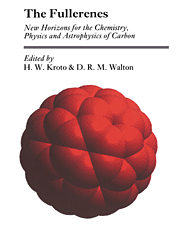Book contents
- Frontmatter
- Contents
- The evolution of the football structure for the C60 molecule: a retrospective
- Dreams in a charcoal fire: predictions about giant fullerenes and graphite nanotubes
- On the formation of the fullerenes
- Production and discovery of fullerites: new forms of crystalline carbon
- Systematics of fullerenes and related clusters
- The fullerenes: powerful carbon-based electron acceptors
- The carbon-bearing material in the outflows from luminous carbon-rich stars
- Elemental carbon as interstellar dust
- The pattern of additions to fullerenes
- Pollyynes and the formation of fullerenes
- Hypothetical graphite structures with negative gaussian curvature
- Fullerenes as an example of basic research in industry
- Deltahedral views of fullerene polymorphism
- Geodesic domes and fullerenes
Dreams in a charcoal fire: predictions about giant fullerenes and graphite nanotubes
Published online by Cambridge University Press: 03 February 2010
- Frontmatter
- Contents
- The evolution of the football structure for the C60 molecule: a retrospective
- Dreams in a charcoal fire: predictions about giant fullerenes and graphite nanotubes
- On the formation of the fullerenes
- Production and discovery of fullerites: new forms of crystalline carbon
- Systematics of fullerenes and related clusters
- The fullerenes: powerful carbon-based electron acceptors
- The carbon-bearing material in the outflows from luminous carbon-rich stars
- Elemental carbon as interstellar dust
- The pattern of additions to fullerenes
- Pollyynes and the formation of fullerenes
- Hypothetical graphite structures with negative gaussian curvature
- Fullerenes as an example of basic research in industry
- Deltahedral views of fullerene polymorphism
- Geodesic domes and fullerenes
Summary
The early prediction of hollow graphite molecules suggested that they should be supercritical under ambient conditions. This is not true of C60, but might still be true of higher fullerenes and graphite nanotubes of large diameter.
Introduction
My title refers to the celebrated vision of Kekulé, one of the founders of the concept of chemical structure. In 1865, staring drowsily one evening into the fire, he saw in a dream the cyclic structure for benzene, that fundamental unit of all aromatic molecules, and of graphite and the fullerenes. In his reverie, he imagined the atoms gambolling before his eyes… ‘one of the snakes had seized hold of its own tail, and the form whirled mockingly before my eyes’ (Kekulé 1890). In this paper I deal, not so much with the recent triumphs of the identification and bulk preparation of buckminsterfullerene, as with its imaginative prehistory. This begins with Dalton's atomic theory, elaborated from 1803 onwards. Despite a very promising start, atomic theory languished for decades as merely a sort of useful metaphor. One good reason was its failure to come up with consistent atomic weights for the elements and formulae for their compounds. Whether, for example, the atomic weight of oxygen was 8 and water was HO, or whether it was 16 with water as H2O, remained uncertain for half a century.
And yet shortly after Dalton proposed his theory, the whole problem had been solved (Avogadro 1811).
- Type
- Chapter
- Information
- The FullerenesNew Horizons for the Chemistry, Physics and Astrophysics of Carbon, pp. 9 - 18Publisher: Cambridge University PressPrint publication year: 1993



